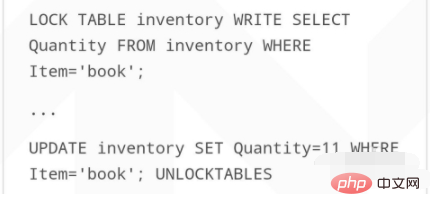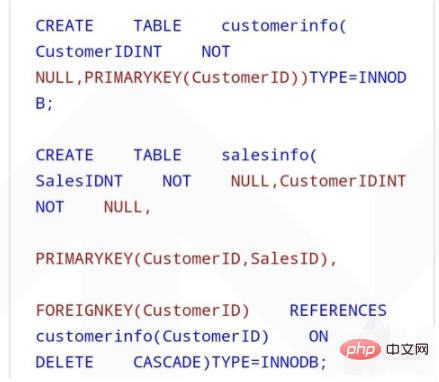Several ways of database optimization
Database optimization methods include: 1. Select the most applicable field attributes; 2. Use connections to replace subqueries; 3. Use unions to replace manually created temporary tables.

The database optimization methods are:
The first method: select the most applicable field attributes. MySQL can support the access of large amounts of data, but the smaller the table in the database, the faster the queries executed on it. Therefore, the field width in the table can be set as small as possible. The figure shows an example of this method.

Related learning recommendations: mysql video tutorial
The second method: use connections instead of sub Query (Sub-Queries). You can use the SELECT statement to create a single column of query results, and then use this result as a filter condition in another query. The figure shows an example of this method.

The third method: Use union (UNION) to replace the manually created temporary table. MySQL can combine two or more select queries that require the use of temporary tables into one query. The figure shows an example of this method.

The fourth method: transaction. Not all database operations can be completed with only one or a few SQL statements. More often, a series of statements are needed to complete a certain kind of work. The integrity and consistency of data in the database can be maintained. The figure shows an example of this method.

The fifth method: lock the table. Since the database will be locked during the execution of the transaction, other user requests can only wait until the transaction ends. In some cases we can get better performance by enlarging the lock table. The figure shows an example of this method.

The sixth method: use foreign keys. The method of locking the table can protect the integrity of the data, but it cannot guarantee the relevance of the data. At this point we can use foreign keys. The figure shows an example of this method.

Related recommendations: Programming Video Course
The above is the detailed content of Several ways of database optimization. For more information, please follow other related articles on the PHP Chinese website!

Hot AI Tools

Undresser.AI Undress
AI-powered app for creating realistic nude photos

AI Clothes Remover
Online AI tool for removing clothes from photos.

Undress AI Tool
Undress images for free

Clothoff.io
AI clothes remover

AI Hentai Generator
Generate AI Hentai for free.

Hot Article

Hot Tools

Notepad++7.3.1
Easy-to-use and free code editor

SublimeText3 Chinese version
Chinese version, very easy to use

Zend Studio 13.0.1
Powerful PHP integrated development environment

Dreamweaver CS6
Visual web development tools

SublimeText3 Mac version
God-level code editing software (SublimeText3)

Hot Topics
 How does Hibernate optimize database query performance?
Apr 17, 2024 pm 03:00 PM
How does Hibernate optimize database query performance?
Apr 17, 2024 pm 03:00 PM
Tips for optimizing Hibernate query performance include: using lazy loading to defer loading of collections and associated objects; using batch processing to combine update, delete, or insert operations; using second-level cache to store frequently queried objects in memory; using HQL outer connections , retrieve entities and their related entities; optimize query parameters to avoid SELECTN+1 query mode; use cursors to retrieve massive data in blocks; use indexes to improve the performance of specific queries.
 Java Spring Boot Security performance optimization: make your system fly
Feb 19, 2024 pm 05:27 PM
Java Spring Boot Security performance optimization: make your system fly
Feb 19, 2024 pm 05:27 PM
1. Code optimization to avoid using too many security annotations: In Controller and Service, try to reduce the use of @PreAuthorize and @PostAuthorize and other annotations. These annotations will increase the execution time of the code. Optimize query statements: When using springDataJPA, optimizing query statements can reduce database query time, thereby improving system performance. Caching security information: Caching some commonly used security information can reduce the number of database accesses and improve the system's response speed. 2. Use indexes for database optimization: Creating indexes on tables that are frequently queried can significantly improve the query speed of the database. Clean logs and temporary tables regularly: Clean logs and temporary tables regularly
 How to improve the access speed of Python website through database optimization?
Aug 07, 2023 am 11:29 AM
How to improve the access speed of Python website through database optimization?
Aug 07, 2023 am 11:29 AM
How to improve the access speed of Python website through database optimization? Summary When building a Python website, a database is a critical component. If the database access speed is slow, it will directly affect the performance and user experience of the website. This article will discuss some ways to optimize your database to improve the access speed of your Python website, along with some sample code. Introduction For most Python websites, the database is a key part of storing and retrieving data. If not optimized, the database can become a performance bottleneck. Book
 How to improve MySQL performance by using composite indexes
May 11, 2023 am 11:10 AM
How to improve MySQL performance by using composite indexes
May 11, 2023 am 11:10 AM
In the MySQL database, indexing is a very important means of performance optimization. When the amount of data in the table increases, inappropriate indexes can cause queries to slow down or even cause database crashes. In order to improve database performance, indexes need to be used rationally when designing table structures and query statements. Composite index is a more advanced indexing technology that improves query efficiency by combining multiple fields as indexes. In this article, we will detail how to improve MySQL performance by using composite indexes. What is composite index composite
 Spring Boot performance optimization tips: create applications as fast as the wind
Feb 25, 2024 pm 01:01 PM
Spring Boot performance optimization tips: create applications as fast as the wind
Feb 25, 2024 pm 01:01 PM
SpringBoot is a popular Java framework known for its ease of use and rapid development. However, as the complexity of the application increases, performance issues can become a bottleneck. In order to help you create a springBoot application as fast as the wind, this article will share some practical performance optimization tips. Optimize startup time Application startup time is one of the key factors of user experience. SpringBoot provides several ways to optimize startup time, such as using caching, reducing log output, and optimizing classpath scanning. You can do this by setting spring.main.lazy-initialization in the application.properties file
 Common database problems in Linux systems and their solutions
Jun 18, 2023 pm 03:36 PM
Common database problems in Linux systems and their solutions
Jun 18, 2023 pm 03:36 PM
With the continuous development of computer technology and the continuous growth of data scale, database has become a vital technology. However, there are some common problems encountered when using databases in Linux systems. This article will introduce some common database problems in Linux systems and their solutions. Database connection problems When using a database, problems such as connection failure or connection timeout sometimes occur. These problems may be caused by database configuration errors or insufficient access rights. Solution: Check the database configuration file to make sure
 From a technical perspective, why can Oracle beat MySQL?
Sep 08, 2023 pm 04:15 PM
From a technical perspective, why can Oracle beat MySQL?
Sep 08, 2023 pm 04:15 PM
From a technical perspective, why can Oracle beat MySQL? In recent years, database management systems (DBMS) have played a vital role in data storage and processing. Oracle and MySQL, two popular DBMSs, have always attracted much attention. However, from a technical perspective, Oracle is more powerful than MySQL in some aspects, so Oracle is able to defeat MySQL. First, Oracle excels at handling large-scale data. Oracl
 How to solve database update performance problems in Java development
Jun 29, 2023 pm 01:00 PM
How to solve database update performance problems in Java development
Jun 29, 2023 pm 01:00 PM
How to solve database update performance issues in Java development Summary: With the increase in data volume and business changes, database update performance issues have become a major challenge in Java development. This article will introduce some common methods and techniques to solve database update performance problems. Keywords: Java development, database, update performance issues, solutions Introduction: In most Java applications, the database plays an important role. The performance of the database directly affects the response speed and stability of the application. In actual development, the number






